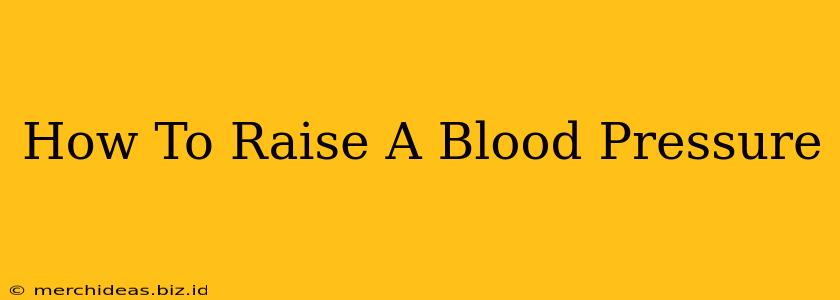Low blood pressure, or hypotension, can leave you feeling dizzy, weak, and fatigued. While it's not always cause for concern, understanding how to raise blood pressure safely and effectively is crucial for maintaining your well-being. This comprehensive guide explores various strategies to help you manage low blood pressure naturally and when medical intervention might be necessary.
Understanding Low Blood Pressure (Hypotension)
Before diving into solutions, let's clarify what constitutes low blood pressure. Generally, a reading below 90/60 mmHg is considered low. However, what's considered "low" can vary depending on individual factors and your body's usual baseline. Symptoms can include lightheadedness, fainting, blurred vision, nausea, and fatigue.
Important Note: This guide provides general information. Always consult your doctor before making any significant changes to your diet, lifestyle, or medication regimen, especially if you have underlying health conditions. Self-treating can be dangerous.
Natural Ways to Raise Blood Pressure
Several lifestyle adjustments can help naturally elevate blood pressure. These methods focus on improving blood volume and circulation.
1. Hydration is Key
Dehydration is a common cause of low blood pressure. Drink plenty of fluids, especially water, throughout the day. Electrolyte-rich drinks can also be beneficial, especially after strenuous activity.
2. Dietary Adjustments for Better Blood Pressure
Your diet plays a significant role. Focus on consuming foods rich in sodium, but do so in moderation. Processed foods, canned goods, and salty snacks are high in sodium. However, excessive sodium intake can be harmful, so moderation is essential. Consult your doctor for personalized sodium recommendations.
Increase your intake of:
- Salt: A small increase in salt intake can help, but don't overdo it.
- Foods rich in sodium: Include salty snacks (in moderation!), processed foods (sparingly), and bouillon cubes in your diet.
- Foods rich in electrolytes: Bananas, coconut water, and oranges are good sources.
3. Lifestyle Changes for Improved Circulation
- Increase Fluid Intake: Staying adequately hydrated is crucial.
- Get Regular Exercise: Moderate exercise improves circulation and overall health.
- Elevate Your Legs: Elevating your legs when resting can help improve blood flow to the brain.
- Avoid Prolonged Standing or Sitting: Change positions frequently to prevent blood pooling.
- Manage Stress: Stress can contribute to low blood pressure. Practice relaxation techniques like deep breathing or meditation.
4. Medication Considerations
In some cases, lifestyle changes alone may not be enough to manage low blood pressure. Your doctor might recommend medication to increase blood volume or constrict blood vessels, thereby raising blood pressure. Never start or stop medication without consulting your doctor.
When to See a Doctor
While some minor fluctuations in blood pressure are normal, persistently low blood pressure warrants medical attention. Seek immediate medical care if you experience:
- Severe dizziness or fainting
- Chest pain
- Shortness of breath
- Rapid heart rate
- Sudden confusion
Regular check-ups and open communication with your doctor are essential for managing your blood pressure effectively and maintaining good health.
Conclusion
Successfully managing low blood pressure often involves a multi-pronged approach that combines lifestyle adjustments and, in some cases, medication. Remember, prevention and early intervention are key. By understanding the causes and implementing the strategies discussed above, you can take proactive steps towards better health and well-being. Always consult with your healthcare provider for personalized advice and treatment options.
